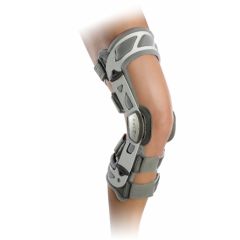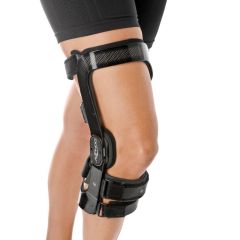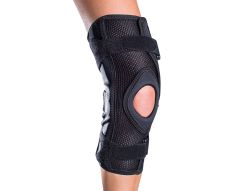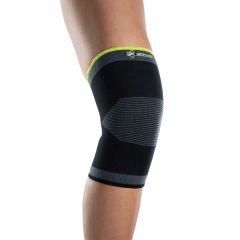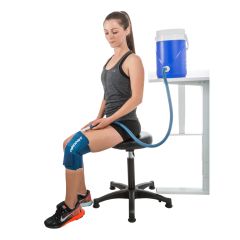Osteoarthritis of the Knee
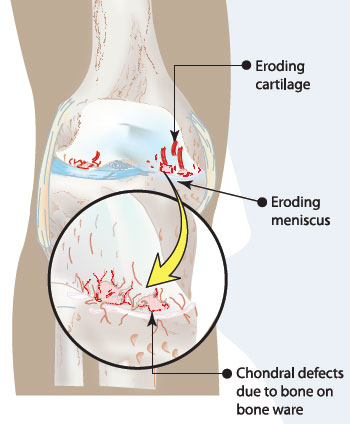
There are over 100 types of arthritis (osteoarthritis, post-traumatic, rheumatoid, etc). The most common form is osteoarthritis, also known as OA or degenerative joint disease (DJD).
Osteoarthritis is characterized by the breakdown of the articular cartilage, the firm whitish-colored rubbery protein material covering the ends of bones. It acts as a cushion and bearing surface between the bones, allowing them to glide smoothly over each other with almost zero friction. Osteoarthritis commonly affects large weight-bearing joints such as the hip and knee, but may affect any joint. Knee osteoarthritis is the most common osteoarthritis, and is the leading cause of disability in the United States.
Causes of Osteoarthritis of the Knee
The exact cause of knee osteoarthritis is unknown. Some contributing factors include: previous injury, aging, misalignment, genetics, and obesity.
Symptoms of Knee Osteoarthritis
The number one symptom of osteoarthritis of the knee is pain. The causes of pain in osteoarthritis include: irritation and pressure on the nerve endings in the bones, inflammation of the joint lining (synovitis), muscle tension and fatigue. The pain may progress from mild soreness and aching with movement to severe pain even during rest. The second symptom is loss of easy movement. As the lining cartilage wears away, the joints no longer glide smoothly. Eventually, the ends of the bones become rough and irregular, with resulting stiffness. This lack of mobility, in turn, often causes the muscles serving the knee to weaken, and overall body coordination suffers. Other symptoms common to osteoarthritis include grinding and "popping" sensations, joint swelling, and feelings of locking or giving way.
The diagnosis of osteoarthritis is usually made based upon the patient's medical history, physical examination, and X-ray findings. An MRI may be helpful in some cases to confirm the diagnosis and rule out any other conditions.
How to Treat Knee Osteoarthritis
Osteoarthritis is not a curable condition. The disease usually progresses slowly or worsens over many years. Therefore, goals include decreasing pain, swelling, and inflammation, while increasing or maintaining joint function. To achieve these goals, a number of different treatments are used. Non-operative forms of pain management may include physical therapy, icing, activity modification, and bracing. Medications such as Tylenol ®, aspirin, or anti-inflammatories help decrease pain and swelling. An over-the-counter supplement containing glucosamine and chondroitin sulfate may be taken long-term to help alleviate symptoms and possibly slow progression of the disease. Cortisone injections into the joint may reduce acute symptoms for several months. Three or four steroid injections may be given per year, in each affected joint, without harm. Some relatively new injectable medications (Synvisc, Hyalgan, or Supartz) may help alleviate symptoms for 6 to 12 months in certain patients. These are administered by a series of 3 or 5 weekly injections, and may be repeated as needed.
Wearing osteoarthritis knee braces can also help alleviate pain as you go about your daily activities. These knee braces work by reducing pressure on the arthritic areas of the knee and offloading it to the healthier areas of the knee.
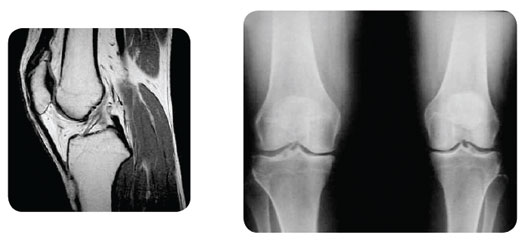
SUPPORT & PROTECTION FOR KNEE OA
View all braces and supports for Knee Osteoarthritis-
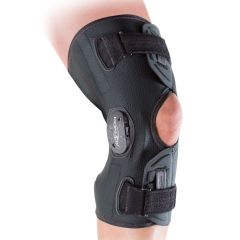 On Sale 0% Off Save $0.00The latest DonJoy OA Knee Brace for patients with mild to moderate OA knee pain.
On Sale 0% Off Save $0.00The latest DonJoy OA Knee Brace for patients with mild to moderate OA knee pain.
Do I Order Left or Right?
Order according to the affected compartment of the knee. For example: If you have OA in the medial compartment of your left knee, order the Medial Left / Lateral Right option. If you have OA in the medial compartment of your right knee, order the Medial Right / Lateral Left option.





